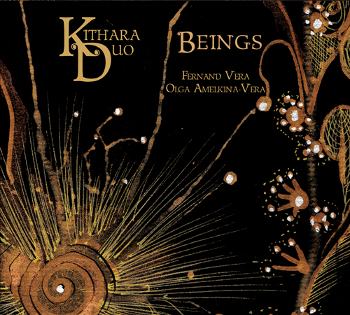Lo que vendrá is an excellent example of Piazzolla's highly personal style that blends Argentinean tango and European art music. Like many of the composer's works, this piece is at times seductive and melancholy, at other times recklessly passionate.
Mario Castelnuovo-Tedesco's Well-Tempered Guitars, Opus 199 is a monumental collection of works for guitar duo. Written in 1962 for the legendary duo of Ida Presti and Alexandre Lagoya, these 24 pairs of preludes and fugues, one in each major and minor key, follow the example of Bach's Well-Tempered Clavier. Out of this rich and varied collection, we have chosen four sets, some relatively unknown, some well established in the guitar duo repertoire. The solemn, forlorn solo opening of Prelude and Fugue in E-flat minor leads to a soaring melody, unfolding unhurriedly over cascading accompaniment. The fugue opens with a sober, gloomy chromatic subject, which is stated several times before an imitative episode of interlocking downward arpeggios. Prelude and Fugue in B-flat major presents a bright contrast to the preceding work. The carefree dance rhythms of the prelude, marked by the composer as "alla rumba," are followed by the humorous interplay of the fugue's burlesque march, reminiscent of a circus procession of mimes and clowns. Prelude and Fugue in B minor is characterized by a noble and serious tone throughout, ranging in mood from anxious and agitated to serene and resigned. Especially beautiful is the fugue, full of elided phrases and continuously-flowing counterpoint. The famous Prelude and Fugue in E major is an exquisite example of Castelnuovo-Tedesco's romantic musical language and solid compositional technique. The prelude's ethereal opening is one of the truly magical moments in guitar duo literature. The fugue's cheerful chatter brings welcome variety after the lush romanticism of the prelude.
This disc is the first recording of my works for guitar duo. The earliest of these is Gustav's Dream (2008), written in homage to Gustav Mahler, whose music I fell in love with several years ago. I had the sound of his symphonies and songs in mind when composing this piece. I tried to imagine what a guitar duo by Mahler might have sounded like, had he written one. I thought of the process of falling asleep as represented in the ABA form of the piece. The first A section is the initial pleasant slumber, followed by a vivid and restless dream (B section), finishing with the deep sleep phase (the return of A material).
Beings (2009), a programmatic work, was conceived as a suite in which each movement depicts a mythological creature. The figure of Minotaur, the monstrous half-man/half-bull from Greek mythology has long fascinated me. The tragic and grotesque nature of his unfortunate birth, his imprisonment in a labyrinth, and his death at the hand of Theseus were all inspirations behind my choices of textures, scales, harmonies, and special effects used in this first and darkest movement of the suite. Sylphs, the second movement, is evocative of the air spirits of Medieval European alchemy. Without weight or physical bodies, myriads of these spirits fill the air around us. I wanted to convey extreme lightness and a feeling of airy spaciousness in this movement. The last movement, Salamander, is inspired by a Medieval European belief in a lizard whose blood is so cold that it is able to live in fire. The minimalist, uncoiling patterns in this composition are intended to be reminiscent of the hypnotic effect that watching fire has on many of us.
Prelude and Bagatelle (2009) is a short work meant to be, in accordance with its title, a musical whim, trifle, caprice. It is capricious because of its many fleeting moods and ephemeral turns of harmony. For this composition, I experimented with placing capos on different frets for each guitar; guitar 1 has a capo on the first fret, and guitar 2 on the fourth. This allowed me to create sonorities and colors not normally available in standard open tuning.
Olga Amelkina-Vera January 2011
Acknowledgments:
We would like to thank our Belarussian, American, French, and Ecuadorian families for their love and support, as well as Frank and Leanne Koonce for their expertise in producing recordings, J. Greco for his invaluable technical advice, and Dr. Chris Morgan of Collin College for graciously offering logistical assistance. We are also grateful to all of you whose insight and instruction over the past few years have influenced our interpretation of this music and the way we play in duo: Matteo Mela, Lorenzo Micheli, Robert Guthrie, Tom Johnson, Mitch Weverka, Sabine Madriguera, Richard Todd, Andrew Zohn, Jeffery McFadden, Marko Feri, and Elliott Frank. A special thanks to Valerie Hartzell for being the first to encourage us to play in duo and for her steadfast support of our musical development.
Produced by: Fernand Vera and Olga Amelkina-Vera Executive Producer: Frank Koonce
Recording Engineer and Digital Editor: Fernand Vera
Mastering Engineer: Dave Shirk, Sonorous Mastering
Program Notes: Olga Amelkina-Vera
Original Album Artwork: Olga Amelkina-Vera
Design, Layout, and Typography: Leanne Koonce
Recorded Fall 2010, Denton, Texas
Copyright 2011: Soundset Recordings
www.soundset.com
Kithara Duo play guitars by Gregory Byers, Willits, California 2006 and 2008. Olga Amelkina-Vera uses Savarez strings. Fernand Vera uses Augustine strings.


 Amazon
Amazon